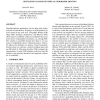Free Online Productivity Tools
i2Speak
i2Symbol
i2OCR
iTex2Img
iWeb2Print
iWeb2Shot
i2Type
iPdf2Split
iPdf2Merge
i2Bopomofo
i2Arabic
i2Style
i2Image
i2PDF
iLatex2Rtf
Sci2ools
WSC
2004
2004
Simulation Analysis of Virtual Geographic Routing
Homeland defense applications will use large-scale ad-hoc networks of small devices. Routing is a crucial problem, for naive means do not scale well. Geographic Routing (GR) (Karp 2000; Giordano, Stojmenovic, and Blazevic 2003) offers hope for scalability, under the assumption that every device knows its geographic coordinates, e.g., through GPS. This solution is unsuitable though when there is no easy means of establishing a device's physical location. indoors. To address this limitation we propose Virtual Geographic Routing where we construct a virtual coordinate space and use GR within it. This paper describes VGR, compares the characteristics of paths VGR identifies with those that GR identifies, then presents theoretical and empirical evidence for its scalability.
Geographic Routing | Large-scale Ad-hoc Networks | Modeling And Simulation | Virtual Geographic Routing | WSC 2004 |
| Added | 31 Oct 2010 |
| Updated | 31 Oct 2010 |
| Type | Conference |
| Year | 2004 |
| Where | WSC |
| Authors | David M. Nicol, Michael E. Goldsby, Michael M. Johnson |
Comments (0)

